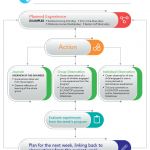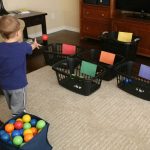One Experience – So much learning
One of the joys of working with young children is the unpredictability. Every day presents a whole new set of challenges, surprises, and humorous moments. I think one of the reasons for this is that children are all unique.

This diversity does present a challenge: if we have 30 children of varying ages in our care each week, how do we plan for differences in learning, interests, personalities, and cultures? That’s a good question.

The good news? There is a solution, and it’s a simple one.
When we plan experiences, we don’t always have to plan a different experience for every child in order to cater for individual needs. Instead, we can plan experiences for the whole room or groups of children that cater for individual children’s unique ways and rates of learning.

Here’s an example: prompted by one of the children bringing in tomatoes from her home veggie patch, the children might have shown a keen interest in plants and where food comes from. So, we decide to plan a series of experiences involving planting and caring for a veggie patch. But, focusing on different outcomes for different children.
Week one: Plant the seedlings
Count seedlings – Cognitive dev milestone: counts 5 to 10 things; touches objects to count. Social development milestone: shares, smiles, cooperates with peers. EYLF Outcomes 1, 2 & 5
Week two to six: Ongoing care of the seedlings and watching them grow
Other experiences might include:
- Reading books related to where food comes from, gardening, insects etc. (Cognitive developmental milestone: recounts a story. EYLF Outcome Group 5)
- Sharing stories about personal gardening experiences. (Language developmental milestone: tells stories. EYLF Outcomes 1 & 5)
- Sharing photos of different gardens and veggie patches belonging to children, grandparents, educators… (Language developmental milestone: takes part in conversations, tells stories, asks and answers questions. EYLF Outcomes 1 & 5)
- Veggie printing (Cognitive milestone: can match and name some colours. EYLF Outcomes 4 & 5)
- Making flowers from recycled material then setting up a flower market (Cognitive developmental milestone: uses materials to construct things, engages in dramatic play. Language developmental milestone: takes part in conversations. EYLF Outcomes 1, 2, 4 & 5)
Week seven: harvesting our veggies
Social developmental milestone: cooperates with peers. Cognitive developmental milestone: follows simple instructions, counts 5 to 10 things. Language: speaks in sentences and uses many different words. EYLF Outcomes 1, 2 & 5.
Week eight: creating healthy lunches using our produce
Cognitive developmental milestone: follows simple instructions and follows simple rules and enjoys helping. EYLF Outcome 3.
Within each planned experience, we might be focusing on different outcomes for different children.
For example, when we are planting the seedlings we might be focusing on social milestones for some children, like cooperating with peers (EYLF Outcome 1 Children learn to interact in relation to others with care empathy and respect).
So, as we are planting out the seedlings, we might encourage these children to take turns planting.
For other children we might be focusing on cognitive milestones like counting (EYLF Outcome 5.4 Children begin to understand how symbols and pattern systems work and Outcome 4.3 Children transfer and adapt what they have learned from one context to another).
We might model counting out the seedlings before and after we plant them, focusing on one to one correspondence with counting.

You get the idea. One planned experience can cater to a variety of outcomes and milestones. And, this is very easy to document in EarlyWorks.
When you plan Experiences, you would include all the outcomes you intend to focus on with all the children.

When you create observations documenting the learning, you can create one shared narrative (description of what happened), one reflection of learning documenting what the children learnt as a group and how they learnt it , and then tick and comment on different outcomes and milestones for each child in the observation depending on the learning observed as well as their individual learning needs.



And it gets better! Photos can be added to observations and even captions added for each photo highlighting the learning evident in the photo.

Educators can also include the voice of each child, showcasing anything the child said that evidences the learning or interests observed.

When families view the observation, they see the shared narrative and shared reflection of learning, however they only see the observed outcomes for their child, the voice of their child, and only the photos their child has been tagged on. And, families can comment on observations.

And so the cycle of learning continues as more gardening experiences are enjoyed by the children and their individual learning and interests nurtured, developed, documented and shared.








